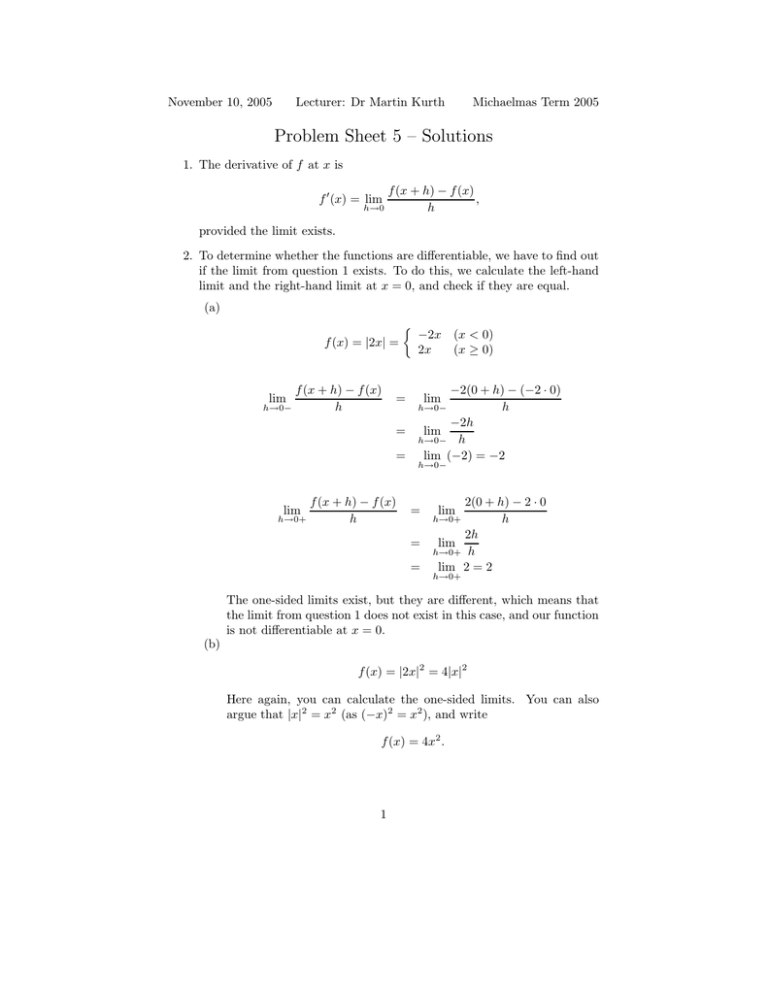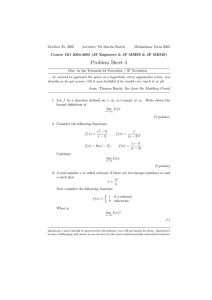Problem Sheet 5 – Solutions
advertisement

November 10, 2005
Lecturer: Dr Martin Kurth
Michaelmas Term 2005
Problem Sheet 5 – Solutions
1. The derivative of f at x is
f (x + h) − f (x)
,
h→0
h
f 0 (x) = lim
provided the limit exists.
2. To determine whether the functions are differentiable, we have to find out
if the limit from question 1 exists. To do this, we calculate the left-hand
limit and the right-hand limit at x = 0, and check if they are equal.
(a)
f (x) = |2x| =
lim
h→0−
f (x + h) − f (x)
h
=
=
=
f (x + h) − f (x)
h→0+
h
lim
−2x (x < 0)
2x
(x ≥ 0)
−2(0 + h) − (−2 · 0)
h
−2h
lim
h→0− h
lim (−2) = −2
lim
h→0−
h→0−
=
=
=
2(0 + h) − 2 · 0
h→0+
h
2h
lim
h→0+ h
lim 2 = 2
lim
h→0+
The one-sided limits exist, but they are different, which means that
the limit from question 1 does not exist in this case, and our function
is not differentiable at x = 0.
(b)
f (x) = |2x|2 = 4|x|2
Here again, you can calculate the one-sided limits. You can also
argue that |x|2 = x2 (as (−x)2 = x2 ), and write
f (x) = 4x2 .
1
As this function is not defined in pieces, we can now proceed to
calculate the limit directly:
f (x + h) − f (x)
h→0
h
lim
4(0 + h)2 − 4(02 )
h→0
h
4h2
= lim
h→0 h
h2
= 4 lim
h→0 h
= 4 lim h = 0
=
lim
h→0
The limit from question 1 exists in this case, and our function is
differentiable at x = 0.
3. This is a straightforward application of the definition:
(a)
f 0 (x)
f (x + h) − f (x)
h
3(x + h) − 3x
lim
h→0
h
3x + 3h − 3x
lim
h→0
h
3h
lim
h→0 h
lim 3 = 3
=
lim
h→0
=
=
=
=
f 0 (x)
=
=
=
=
=
=
h→0
f (x + h) − f (x)
h
3(x + h)2 − 3x2
lim
h→0
h
3x2 + 6xh + 3h2 − 3x2
lim
h→0
h
6hx + 3h2
lim
h→0
h
h
h2
6x lim + 3 lim
h→0 h
h→0 h
6x lim 1 + 3 lim h = 6x
lim
h→0
h→0
h→0
4. The definition given in the lecture (and in the book) only applies to continuity at interior points and endpoints of the domain. It cannot be applied
to isolated points of the domain, whereas the definition on the problem
sheet can.
2
Now define (for example) the function f (x) = x on the domain
D = (−∞, −1) ∪ {0} ∪ (1, ∞),
ie the function is defined at x=0 and and at all real numbers x that are
smaller than −1 or greater than 1. The definition from the lecture does
not allow you to determine whether f is continuous at x = 0, since 0 is an
isolated point of the domain, ie neither an interior point or an endpoint.
According to the problem sheet definition of continuity, f is continuous
at x = 0. Choose any > 0, and then set δ = 1/2, for example. Then
the only x in the domain of f with |x − 0| < δ is x = 0, and clearly
|f (0) − f (0)| < .
This definition of continuity (which is the one generally used by mathematicians) leads to the following
Theorem: Every function is continuous at isolated points of its domain.
3






